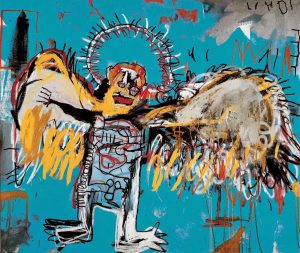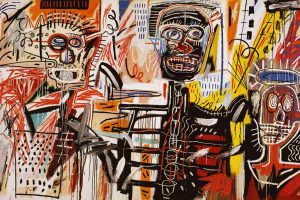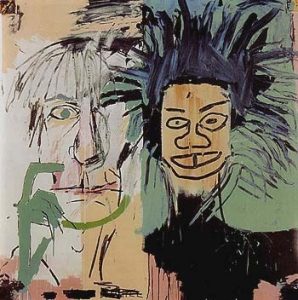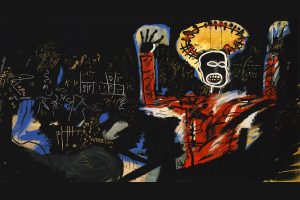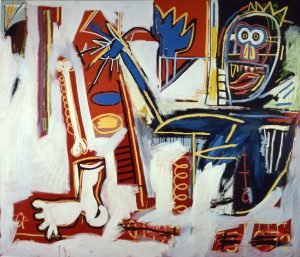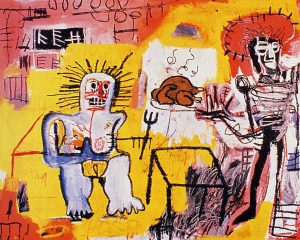In a crowded and overpopulated millennial art market Jean-Michel Basquiat was the rare occurence of a true genius. And his genius was for immediacy. He immediately did things right and did not need to have a program or ideology or philosophy so that, like in the case of Modigliani, there wouldn´t actually be much to add to and analyse about his artwork. – We can, however, say that Jean-Michel gave an impression about how a painting could look like at the turn of the millenium and that he made a solid statement that, with the right attitude, after the supposed death of painting (by exhaustion) authentic painting is still a possibility. – In the works of Basquiat you have the credible erection of figure! You have the masterful use of colour! You have spatiality and the location of the figure in the world (a somehow flat and immediate, but also hypertextual space that is both segmented and has open/undefined ends)! You have individual physiognomy (with the personnel being both individuals, types, caricatures and – what is essential to art – „more human than human“)! Although it is suggested that Basquiat´s painting style is „raw“ (and associates, e.g., to Dubuffet) it is actually immediate and the figures usually are complex and sophisticated. Also Basquiat has been labelled a Neo-Expressionist (like other artists of that time), but with expressionism you would, somehow, associate a content that is dynamic and that emerges out of itself, still has hidden meaning, but in Basquiat´s paintings nothing seems to be hidden. Everything is there and is fully illuminated and in bloom. Masterful – no, genius! – how the seeming immediacy (and „rawness“) he puts something on the canvas with and suddenly nothing else needs to be added (and with his immediately drawn double portrait of Warhol and himself, with which he tried to approach Andy, he immediately stunned Warhol). You have the highly associative intelligence of the genius as Basquiat never hesitates to put all kinds of stuff that crosses his mind into his paintings making up for the rich and saturated and (ironically) suggestive texture a great painting is about. Basquiat´s paintings even allude a bit of parody on painting – and in the respect that it´s definitely not but may seem to carry it, it adds another aspect and to the completeness and multidimensionality.
Complexity and immediacy – on the one hand a sharp contour and great definedness, on the other hand an elusiveness and enigmatic openness – was what Jean-Michel Basquiat possessed and what helped him make him a star. It was also this mix of coming up expectedly, but in an unexpected way. A black guy who was socialised with Afroamerican as well as white (counter)culture. Who hung around in East Village at the turn of the 1980s. Who turned graffiti into „something (artistically) serious“. A street artist who made it clear that his desire was to become a glamorous star (and, as such, was dragged into a world with which he actually could not identify either). A wanderer between worlds, both integrated in all of them and isolated from/in all of them. An early demise (at the wicked age of 27) due to heroin. This spring a work by Jean-Michel sold at a record price of 110,5 million dollars at Sotheby´s (to a Japanese online retail magnate, Yusaku Maezawa). Already when he was alive Basquiat would do senseless things like renting an entire floor in a hotel because he made so much money – on one occasion, and putting bundles of money into the pockets of the homeless on another. You had the mysteriousness and the heavenly impertinence of the genius. They called him the Radiant Child.
I took minor notice of Jean-Michel all over the years of couse, via art books like Fineberg´s Art Since 1940, etc. There are usually some paintings shown by major/remarkable artists and those presented by Basquiat actually didn´t really have an impression on me. Yet a while ago I bought a whole book about Basquiat, and that was when it did „take“, and so I wanted to write a note about him because I was shaken by his importance. When I looked at his stuff again now, I have to admit that I wasn´t that struck anymore, but that may change again and at any rate I found it necessary to sing this hymnos and paint this tableau. In the chapter about the East Village art scene in Art Since 1940 there follows a chapter about David Wojnarowicz. I have not come close to Wojnarowicz so far (so that maybe there may happen the same epiphany I had with Basquiat). Before he became an artist he worked as a male prostitute (and died of AIDS at age 38). His memoirs have the intriguing title Memories That Smell Like Gasoline. But I could not get them so far.

